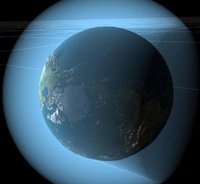
The oldest signs of animal life appear in the geologic record 600 to 700 million years ago. For the four billion years prior, our planet experienced dramatic changes that paved the way for this milestone. Beyond the establishment of the Earth’s earliest oceans perhaps as early as 4.4 billion years ago (Ga), the single most important environmental transformation in history may have been the first permanent rise of atmospheric oxygen around 2.3 to 2.4 Ga, at the so-called Great Oxidation Event (GOE). Before then, Earth’s atmosphere and oceans were virtually devoid of this gas, which forms the basis for all macroscopic life. Yet key questions remain about the timing and triggers of the first biological O2 production, now tentatively placed at 3 Ga, and the first appearance of animals almost two-and-half-billion years later. This talk will lay out the history of early oxygenation with an emphasis on the long delay between initial oxygenation and the expansion of complex life.
Recent work suggests that the initial rise of oxygen may have been protracted, occurring in fits and starts rather than a single step—and that once permanently present in the atmosphere, oxygen likely rose to very high levels and then plummeted. At least a billion years of dominantly oxygen-free conditions in the deep ocean followed beneath an atmosphere and shallow ocean that may still have been oxygen lean. Oxygen and associated nutrient deficiencies may, in turn, have set a challenging course for many of the ocean’s simple microscopic inhabitants, including persistently low populations and diversities of the earliest eukaryotic organisms. The newest data suggest that these billion-plus years of ‘intermediate’ oxygen and life were followed by increases in ocean/atmosphere oxygen contents and eukaryotic diversity that appear to anticipate the famous snowball Earth glaciation that began roughly 700 million years ago. The discussion will emphasize new proxy perspectives on these evolving redox conditions and their cause-and-effect relationships with early life.
 Getting Under Europa’s Skin
Getting Under Europa’s Skin Tracing Formation and Evolution of Outer Solar System Bodies Through Stable Isotopes and Noble Gas Abundances
Tracing Formation and Evolution of Outer Solar System Bodies Through Stable Isotopes and Noble Gas Abundances Photosynthesis, a Planetary Revolution
Photosynthesis, a Planetary Revolution Xenon: King of the Gases
Xenon: King of the Gases